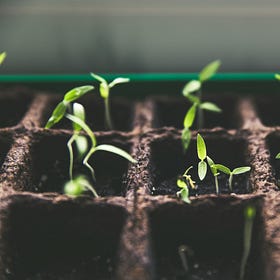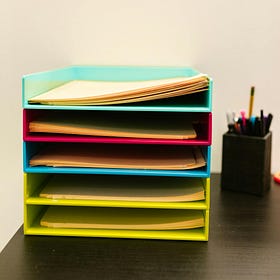Managing a growing note library—especially when approaching or have surpassed 10,000 notes—can feel overwhelming. Yet the goal is clear: spend minimal time and effort on organization while maximizing efficiency when retrieving important ideas. The system itself should serve your projects, tasks, and life goals, not become an end in itself.
Previously, I emphasized retrieval methods—folders, tags, and links—to locate specific notes. Now, I want to share strategies on using folders, tags, and links to build a robust, flexible note-taking system that enhances your creative workflow without draining your energy. This foundation will subsequently facilitate efficient note retrieval in the future.
Keeping the Ultimate Goal in Mind
Before diving into the methods, it's crucial to remember one principle: note management techniques are merely tools. The ultimate goal is achieving your tasks and objectives in work and life. Your system should facilitate, not dominate, your workflow. Spending excessive time creating overly complex structures defeats the purpose, leaving you less energy to achieve actual goals.
Therefore, the strategies shared here are designed to be simple and sustainable, enhancing your note-taking system without unnecessary complexity.
Folder Strategies: Simple and Delightful
Folders are more than just containers; they provide an intuitive starting point for broadly categorizing notes. Structuring main folders around life priorities—such as Work, Life, and Development—can streamline access significantly. Supplement these primary folders with supporting ones like Templates, Daily Notes, References, and Attachments, providing essential but secondary support.
A useful trick I personally employ is adding numerical prefixes to folder names (e.g., 100-Work, 200-Life). This numbering places critical folders at the top, instantly distinguishing priority areas from auxiliary folders like Attachments or References, which naturally fall lower on the list. This simple trick not only reinforces priority but also speeds up your workflow.
Visual tweaks, such as adding emoji icons or other symbolic prefixes, can make the experience more enjoyable. Recently, after years of plain folder names, I started using the Iconize plugin in Obsidian to assign meaningful emojis to folders. For example, I chose a calendar emoji for Daily Notes, symbolizing regularity and routine, and a sprouting seed emoji for my Topic Inbox, representing how ideas gradually grow and develop. Surprisingly, these small visual improvements significantly increased my joy and motivation whenever I accessed my notes. However, it’s important to remember that any visual or structural enhancement must be balanced against your ultimate goals. Spending too much time perfecting the appearance of your system can detract from the real work your notes are meant to support.
Moreover, I use a buffer folder structure to manage notes. I maintain two distinct vaults: one for mobile and another for desktop. Initial thoughts captured on mobile devices often end up in a general buffer folder in the mobile vault. Later, on my desktop, I prioritize sorting significant notes first, leaving less important ideas in the mobile vault. Through personal experience, I've found this method efficient—important notes remain highly visible, and less critical ones remain accessible through keyword searches, minimizing the risk of information loss without excessive overhead. This method acknowledges that not every fleeting thought needs immediate categorization. Instead, allow your system to naturally differentiate between core ideas and peripheral musings.
Tagging Simplified: Less is More
Tags can be a powerful way to slice your notes into smaller, more precise topics. However, caution is essential. When you create too many tags, it becomes nearly impossible to remember which tags you’ve assigned, making retrieval a challenge. Similarly, multiple keywords for a single note might seem helpful initially, but future retrieval becomes problematic—you might not remember exactly which tags you used in a note months ago.
My recommendation is to create tags sparingly and leverage existing ones whenever possible. Moreover, instead of sprinkling a dozen similar keywords throughout your notes, adopt a naming convention that consistently using prefixes or nested tags. For example, prefixing tags with "Work" or "Life" ensures related tags automatically group together. Obsidian's intuitive tag suggestions based on your existing tags simplify this further, reducing mental load and streamlining tag management.
I've encountered the temptation to excessively tag notes, hoping future searches will be easier. However, practical experience showed me this method leads to confusion and increased workload. Keeping tags minimal and focused works far better. Sometimes, adding a quick reminder at the top of a note (or even a task list) to “consider additional tags later” can be a practical compromise. This method ensures you don’t get bogged down by tagging minutiae during a busy moment, while still leaving a cue for further refinement when time permits.
The temptation to let artificial intelligence do the heavy lifting is strong. While several AI plugins can analyze note content and suggest tags, there is always the risk that they may not fully align with your personal language and conceptual framework. By engaging in the tagging process manually, you reinforce your understanding of the note’s context and maintain a personal connection to your material.
Leveraging Links: Context and Discovery
Linking notes is a cornerstone of methodologies like the Zettelkasten (slip-box) method. When you connect a note with a few related ideas, you create pathways for unexpected insights. However, in the early days of note-taking, it might seem beneficial to link one note to as many others as possible. As your collection grows, though, this practice can become counterproductive. Instead, now I link notes strategically—focusing on immediately relevant or recent connections.
To aid this, I frequently create "Entry Notes"—centralized hubs collecting links on specific themes like projects, hobbies, or personal development. These Entry Notes serve as anchors, efficiently guiding future access. For instance, if you have several notes about exercise—ranging from basketball and soccer to iceball—an entry note can aggregate these, providing a clear reference point for future exploration.
A common pitfall is to expect yourself to remember every keyword or connection. Instead, as you develop or revisit a note, quickly add the links that come naturally to mind, and then place a small reminder within the note to explore further connections later. This way, you maintain a balance between immediate usability and long-term depth without overburdening your workflow.
Intentional Redundancy for Reliability
Relying on a single method alone may not deliver satisfactory results in note management and knowledge retrieval. Excessive use of folders can result in overly complex hierarchical structures, making it difficult to categorize and locate notes. Improperly using tags can lead to a cluttered, hard-to-manage tag system, making it challenging to effectively use tag combinations to find specific notes. Similarly, excessive linking can produce an overly complicated graph with limited practicality, hindering the discovery of meaningful, unexpected connections in the future.
On the other hand, employing multiple organization strategies—folders, tags, and links—may seem redundant. Yet, intentional redundancy enhances reliability. SpaceX exemplifies this concept; despite engine failures, redundant systems allowed Starship launches to succeed. Similarly, your note system benefits from overlapping, complementary methods.
However, each method must remain simple:
Use broad categories for folders.
Add only a few intuitive tags.
Link clearly connected notes.
The key is not to overcomplicate each individual method. Rather, it’s about establishing a reliable framework where each method complements the others. Folders might quickly point you to a general area, while tags refine the search, and links illuminate related ideas. Together, these strategies prevent the system from collapsing under the weight of its own complexity and ensure that your digital second brain remains effective and accessible.
With this simplified approach, you build a resilient network that increases the likelihood of rediscovering important ideas when you need them. Moreover, this method prevents burnout. Moving notes takes seconds, tagging or linking takes mere minutes.
Sustainable Simplicity
Ultimately, the purpose of any note-taking system is to serve you. It should help manage your ideas, support your projects, and free up your time to focus on what truly matters. The strategies described here are not about creating a perfect or fancy system—they are about developing a practical, balanced approach that minimizes the time and effort required for maintenance.
By using a simple folder hierarchy with clear priorities, a restrained yet consistent tagging system, and a thoughtful linking method, you create a self-reinforcing network that grows with you. Reminders and buffers allow you to handle the inevitable influx of ideas without getting overwhelmed. And the built-in redundancy ensures that even if one method falls short, another will catch the important connections you need.
As you refine your system, remember that the goal is not to manage the notes for their own sake but to empower you in your work and life. With a few simple strategies, you can build a note-taking system that not only stores your ideas but actively helps you discover and connect them when you need inspiration the most.
Conclusions
Embrace these methods and tailor them to your personal workflow. Your digital second brain is an evolving tool—a living system designed to serve your goals, not a burdensome chore to maintain. In the end, the true measure of success lies in how effortlessly your ideas can be retrieved and applied, paving the way for ongoing creativity and achievement.
Related Reading
Navigating an Evolving Obsidian Vault: Practical Strategies for Efficient Note Retrieval
I recently took a closer look at my primary Obsidian vault and discovered that it now contains over 10 k notes. I had initially expected an even higher number, so I turned to two different Vault Size plugins to observe the evolution of the note count. After verifying with these tools and reviewing the Obsidian Sync logs from the past couple of months—wh…
Build a Second Brain That Works for You, Not the Other Way Around
The concept of a "second brain"—an external system to capture and organize our knowledge—has gained popularity as a means to manage information overload. Tools like Obsidian and methodologies like Zettelkasten (slip-box) promise enhanced creativity and productivity through meticulous note-taking, linking, and tagging. However, an important question aris…








I have just discovered your content, thanks, it's informative and inspiring. A key message for me in this article is the importance of simplicity. I can easily fall into Obsidian rabbit holes, in fact, I just clawed my way out one (your amazing https://obsidianjourney.com/posts/obsidian-plugins-showcase---may-20th-2025/#disciples-journal). I am wondering if, in addition to the plugins showcase, you could help easily distracted people by adding an update such as "new plugins I have installed."